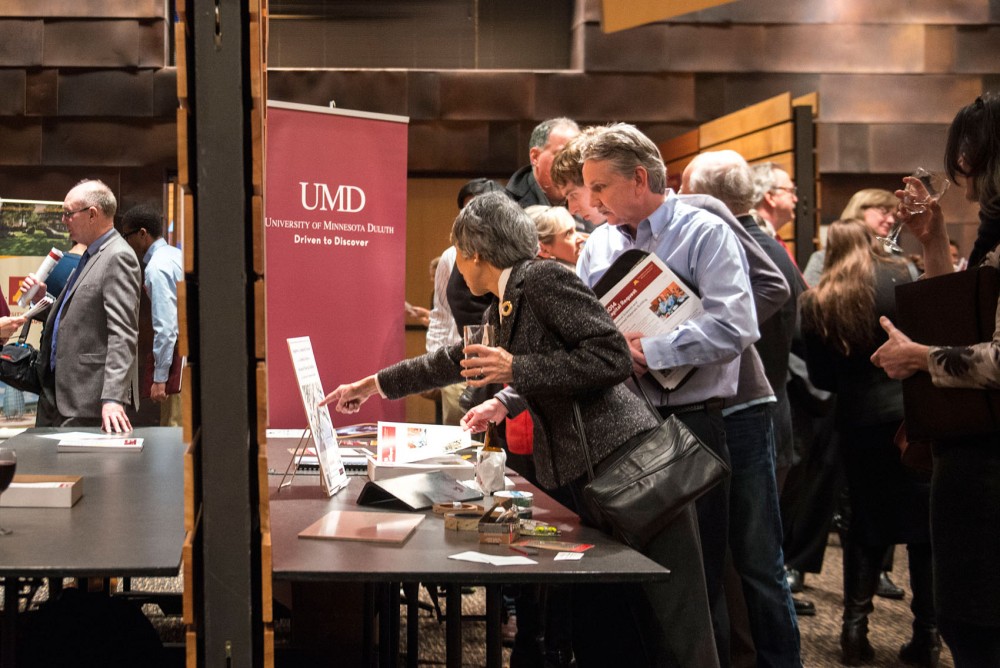University of Minnesota President Eric Kaler announced a plan to freeze tuition, and a crowd of hundreds erupted into applause, ready to start lobbying at the Capitol in St. Paul.
That was last year.
A quieter and smaller group of alumni, students, faculty and staff filled the McNamara Alumni Center on Wednesday for this year’s legislative briefing and reception. The University is requesting funding for six construction projects across its five-campus system, hoping for more than $230 million in the state’s bonding bill.
“We need wiring and septic systems,” Kaler said to the crowd. “We need elevators across the system. Are they dramatic and sexy? Not so much, but they’re necessary, very much so.”
Last year, lobbying efforts were strong and focused on the University’s tuition freeze proposal, which enjoyed strong student support. Now, efforts are concentrated on securing funding for building renovations, construction and maintenance and upkeep.
“It’s always hard in a bonding year to really get people excited,” said Matt Smriga, the University’s legislative advocacy coordinator.
Gov. Mark Dayton’s bonding recommendation, released last month, includes funding for three of the six requested projects and 40 percent of the University’s $100 million Higher Education Asset Preservation Replacement funding request. The Minnesota House of Representatives and Senate will also draft bonding proposals before a final bill passes this legislative session.
Because this year’s request has a less direct effect on students’ pocketbooks, Smriga said University officials plan to gather student support by focusing on individual groups, targeting students who frequent the buildings included in the capital request projects.
“It is more difficult to reach out and recruit students, and I knew that,” he said.
Matt Forstie, chairman of the Minnesota Student Legislative Coalition, said the group plans to use existing University buildings to show students how bonding funds can be used. The Science Teaching and Student Services building, for example, was built using 2008 capital request funds. That connection will help students realize the importance of this year’s request, Forstie said.
One of the projects outlined in the University’s capital request asks for nearly $57 million to renovate the Tate Laboratory of Physics. Dayton recommended funding for the project in his proposal. Forstie said the coalition plans to talk to students who work in the lab and try to get them involved in the legislative process.
“They know what these projects will do; they just need help communicating their stories to the decision makers,” he said.
Kelly Stifter, an astrophysics and math junior who spends a lot of time in Tate, said infrastructure problems, specifically issues with the building’s heating and cooling systems, distract students during class.
“However good the classes are, they suffer because of the environment they’re taught in,” she said.
A tuition freeze might have been easier for students to get behind, Stifter said, but pushing for Tate renovations should also be a priority.
The project is the most important in the University’s capital request because it affects the moswt students, Stifter said. Nearly 4,000 students have classes in Tate each year, most of them within the physics department.
“I think that if you ask any physics student in Tate, they’re going to tell you that is the most important thing to them,” she said.
Dayton also supported the University’s entire $10 million request to build a new wellness center on the University’s Crookston campus.
Barbara Keinath, vice chancellor for academic affairs at Crookston, said students on campus strongly support the bonding request because they believe it’s needed. The Crookston campus hasn’t had a project this large in the institution’s capital request for many years, Keinath said.
The existing Sports Center in Crookston is more than 80 years old, and Keinath said it’s too small for both athletes and students to share. The student population on campus has nearly doubled since 2006.
If state funding is set aside for the project, a new fitness area with updated equipment will be built, adding 35,000 square feet to the existing building.
About 100 students RSVP’d for Wednesday’s event. Kaler told the crowd he was pleased with Dayton’s bonding recommendation but would like to see students connect with their legislators and advocate for the full funding amount.
“There will be winners and there will be losers in this conversation,” Kaler told the crowd. “If we don’t make our voices heard … there are plenty of people willing to take those dollars.”








